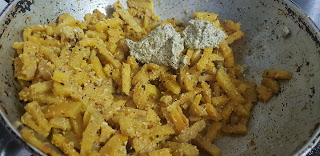Rajasthani food is vast and I'm a big fan of it especially its desserts. The aroma of ghee is so tempting. The richness comes from the usage of dry fruits and khoya. I still don't know whether its 'Khoya' or 'Khowa' but I love to include it in my desserts. People tell me that I have a 'sweet tooth' but the reality is my entire mouth is a sugar addict. My mood becomes fresh whenever I take a bite of my favourite dessert. I think this happens with every sweet lover.
Mawa or Khoya malpua with rabri is a classic Rajasthani dessert. I absolutely love to indulge my hot malpuas with chilled rabri. In this recipe, I've added some twist to the rabri and malpua. I always love to add some innovation to my recipes. Read below to find out the recipe.
Ingredients:
For the Malpuas:
For the rose syrup:
Mawa or Khoya malpua with rabri is a classic Rajasthani dessert. I absolutely love to indulge my hot malpuas with chilled rabri. In this recipe, I've added some twist to the rabri and malpua. I always love to add some innovation to my recipes. Read below to find out the recipe.
Ingredients:
For the Malpuas:
- Mawa or Khoya: 250 gms
- Milk: 500ml
- Maida: 100 gms
- Sooji or Rava: 50 gms
- Baking Powder: 1/2 Tsp
- Baking soda: 1/4 tsp
- Sugar:1/2 a tsp
- Saunf Powder: 1 Tsp
- Crushed Black Pepper: 1 Tsp
- Ghee: For deep frying
For the Syrup:
- Sugar: 2 cups
- Water: 2 cups
- Rose petals: 1 cup
- Rose essence: a few drops
- Juice of a lemon
For the Rabri:
- Milk: 1 litre
- Carrot: 3 no.s
- Cardamom or Elaichi powder: 1/2 tsp
- Ghee: 2 tbsp
- Sugar: 6 Tbsp (More or less according to your taste)
Method:
For the Rabri:
- Peel cut and boil the carrots and let it cool down a bit.
- In a blender, blend the carrot, cardamom powder and sugar into a fine paste.
- Heat ghee in a frying pan and add the carrot mixture and cook it the way you cook carrot halwa in a medium to low flame. But remember to keep the colour of the carrot orange.
- After 3 minutes, add the milk and let it come to a boil.
- Now, wait for the milk to turn thick and keep stirring in between to prevent it from burning. Also, scrape the sides of the pan and add the milk particles to the rabri.
- Cook till the rabri becomes thick according to your desired consistency.
For the Malpuas:
- Boil the milk and switch of the flame. Wait for a few minutes and the khoya to the milk and gently stir to make the khoya incorporate to the milk and set aside.
- Sift in the dry ingredients except for the sooji and sugar. After sifting, add the sooji, sugar and the milk mixture little by little and make a batter neither too thick nor too thin. Add maida if the batter is too thin and add milk if you find the batter to be too thick. It should have a pouring consistency and set aside for 30 minutes.
- After 30 minutes, heat ghee in a kadhai, use a rounded ladle to pick some mixture and pour in into the hot ghee. Make sure the kadhai is thick from the bottom.
- Don't disturb the malpuas. The may appear to be getting stuck to the bottom of the kadhai. With time they will come up for sure. If it doesn't come up on its own, use a metal tong to lift up the malpuas very gently.
- Fry till it turns golden brown from both sides and put it over paper towels for excess fat absorption.
- In a deep bottomed pan add the sugar and water and let it come to a boil.
- Add the rose petals and lemon juice.
- Cook until you get the syrup in one string consistency.
- Add a few
For serving:
Put the malpuas to the hot syrup and let it stand for a few minutes. Now pour some rabri on a plate and place the malpuas gently on top. Garnish with rose petals and sliced pistachios.
Tip:
- Malpuas require resting time. Make sure you make them rest for 30 minutes to an hour for the better outcome. Meanwhile you can complete the other steps.
- BE GENTLE WITH THE MALPUAS WHILE FRYING AND BE PAITENT. I was impatient while cooking my first batch and used a metal spatula (our beloved khunti) to pick up the malpuas resulting a ruined one. Wait for atleast 2 to 3 minutes before turning sides of the malpuas. Always fry them medium to low flame.
- Don't get disheartened if the malpuas don't turn out properly. I ruined 6 malpuas before getting the beautiful golden ones.
Hope you enjoyed the recipe. I had clicked many pictures but lost them due to some reasons. If you are stuck somewhere in between the steps, ask me. I'll be there for your help. The recipe looks tough but in reality, it isn't. If I can make it, everyone can.

































































